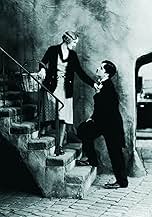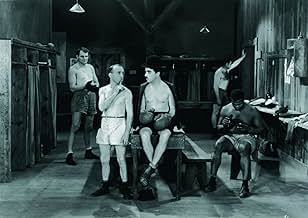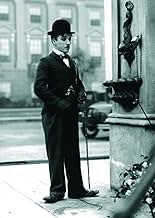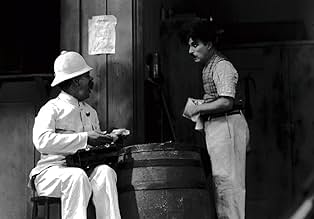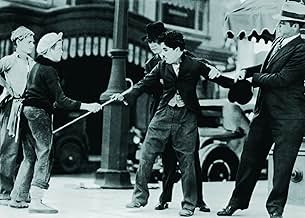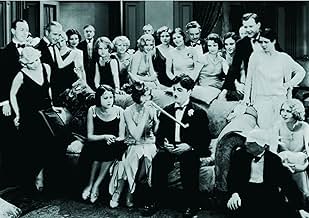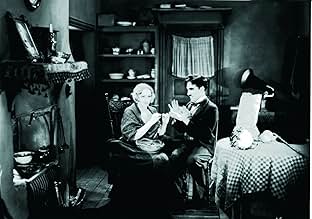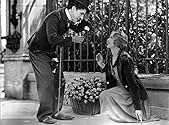ÉVALUATION IMDb
8,5/10
204 k
MA NOTE
Charlot vagabond vient en aide à une jeune fleuriste aveugle et se fait passer pour un homme riche. A force de travail il réunit assez d'argent pour que la jeune fille recouvre la vue.Charlot vagabond vient en aide à une jeune fleuriste aveugle et se fait passer pour un homme riche. A force de travail il réunit assez d'argent pour que la jeune fille recouvre la vue.Charlot vagabond vient en aide à une jeune fleuriste aveugle et se fait passer pour un homme riche. A force de travail il réunit assez d'argent pour que la jeune fille recouvre la vue.
- Prix
- 4 victoires au total
Charles Chaplin
- A Tramp
- (as Charlie Chaplin)
Al Ernest Garcia
- The Millionaire's Butler
- (as Allan Garcia)
Johnny Aber
- Newsboy
- (uncredited)
Jack Alexander
- Boxing Match Spectator
- (uncredited)
T.S. Alexander
- Doctor
- (uncredited)
Victor Alexander
- Superstitious Boxer
- (uncredited)
Albert Austin
- Street Sweeper
- (uncredited)
- …
Harry Ayers
- Cop
- (uncredited)
Eddie Baker
- Boxing Fight Referee
- (uncredited)
Henry Bergman
- Mayor
- (uncredited)
- …
Edward Biby
- Nightclub Patron
- (uncredited)
Buster Brodie
- Bald Party Guest
- (uncredited)
Jeanne Carpenter
- Diner in Restaurant
- (uncredited)
Histoire
Le saviez-vous
- AnecdotesChaplin re-shot the scene in which the Little Tramp buys a flower from the blind flower-girl 342 times, as he could not find a satisfactory way of showing that she thought the mute tramp was wealthy.
- Gaffes(at around 50 mins) When the man swallows part of the Tramp's soap and starts spraying bubbles, the tube used to spray the bubbles is clearly visible behind him.
- Citations
The Tramp: You can see now?
A Blind Girl: Yes, I can see now.
- Autres versionsAbout seven minutes of footage of Georgia Hale playing the flower girl exists and is included in the 2003 DVD release. The footage was shot during a brief period when the actress originally cast to play the character had been fired and replaced with Hale, but Charles Chaplin was forced to resume filming with the original actress due to the amount of film already shot.
- ConnexionsEdited into Histoire(s) du cinéma: Fatale beauté (1994)
Commentaire en vedette
I always thought this was one of Charlie Chaplin's nicest, most under-appreciated silent movie gems. Then I discovered it really wasn't underrated; it's rated very high on most critics' lists. It may be that I usually hear about some of his other movies than I do this one.
Part of the reason I think so highly of this is simply that I'm a sentimentalist and story in this film is a very touching one. It's a romance between Charlie's tramp character (no name) and a blind girl, who also had no name in this film. Virginia Cherill, who played the blind woman and had a wholesome, pretty face which I found very attractive.
I'm not always a huge fan of pantomime except for some great comedians of the era like Chaplin, Harold Lloyd and Buster Keaton, but Chaplin was so good at it and this is one of the last of dying breed as "talkies" were out in full force by 1931. Chaplin was at his best in silent movies, anyway, and his comedy routines are legendary. He gave me a lot of laughs in this film, as always, and I particularly laughed (I love slapstick) at the boxing scene. Kudos, too, to Harry Myers as the "eccentric millionaire."
There's a lot of drama as well as humor in this 86-minute gem as the Tramp tries to aid a blind girl, raising money so she can get an operation to restore her sight.
Comedy, romance, drama (with suffering) all combine to make this an extraordinary piece of entertainment. It's hard to believe this movie was not up for one, single Academy Award.
Part of the reason I think so highly of this is simply that I'm a sentimentalist and story in this film is a very touching one. It's a romance between Charlie's tramp character (no name) and a blind girl, who also had no name in this film. Virginia Cherill, who played the blind woman and had a wholesome, pretty face which I found very attractive.
I'm not always a huge fan of pantomime except for some great comedians of the era like Chaplin, Harold Lloyd and Buster Keaton, but Chaplin was so good at it and this is one of the last of dying breed as "talkies" were out in full force by 1931. Chaplin was at his best in silent movies, anyway, and his comedy routines are legendary. He gave me a lot of laughs in this film, as always, and I particularly laughed (I love slapstick) at the boxing scene. Kudos, too, to Harry Myers as the "eccentric millionaire."
There's a lot of drama as well as humor in this 86-minute gem as the Tramp tries to aid a blind girl, raising money so she can get an operation to restore her sight.
Comedy, romance, drama (with suffering) all combine to make this an extraordinary piece of entertainment. It's hard to believe this movie was not up for one, single Academy Award.
- ccthemovieman-1
- 14 juill. 2007
- Lien permanent
Meilleurs choix
Connectez-vous pour évaluer et surveiller les recommandations personnalisées
Détails
- Date de sortie
- Pays d’origine
- Site officiel
- Langues
- Aussi connu sous le nom de
- City Lights
- Lieux de tournage
- société de production
- Consultez plus de crédits d'entreprise sur IMDbPro
Box-office
- Budget
- 1 500 000 $ US (estimation)
- Brut – États-Unis et Canada
- 19 181 $ US
- Fin de semaine d'ouverture – États-Unis et Canada
- 9 102 $ US
- 8 juill. 2007
- Brut – à l'échelle mondiale
- 55 154 $ US
- Durée1 heure 27 minutes
- Couleur
- Mixage
Contribuer à cette page
Suggérer une modification ou ajouter du contenu manquant

Lacune principale
What is the streaming release date of Les lumières de la ville (1931) in Brazil?
Répondre
